A Strain-Softening Constitutive Model of Heterogeneous Rock Mass Considering Statistical Damage and Its Application in Numerical Modeling of Deep Roadways
Abstract
:1. Introduction
2. Development of the Statistical Damage (SSD) Model
2.1. Strain-Softening Behavior of Rocks
2.2. Statistical Damage Constitutive Model
2.3. Heterogeneity in Rocks
2.4. Implementation of the SSD Model in FLAC3D
2.5. Uniaxial Compression Test Based on SSD Model
3. Engineering Application
3.1. Geological Background
3.2. Numerical Model Establishment
3.3. Results Analysis
3.3.1. Unsupported Condition
3.3.2. Under Primary Support
4. Conclusions
Author Contributions
Funding
Acknowledgments
Conflicts of Interest
References
- Hoek, E.; Brown, E.T. Underground Excavations in Rock; Institution of Mining and Metallurgy: London, UK, 1980. [Google Scholar]
- Hudson, J.A. Rock Engineering Systems: Theory and Practice; Ellis Horwood: New York, NY, USA, 1992. [Google Scholar]
- Jing, L.R. A review of techniques, advances and outstanding issues in numerical modeling for rock mechanics and rock engineering. Int. J. Rock Mech. Min. Sci. 2003, 40, 283–353. [Google Scholar] [CrossRef]
- Jiang, Q.; Feng, X.T.; Zhou, H. Study on acceptable minimum interval of long deeply-burial hydropower tunnels in Jinping II Hydropower Station. Rock Soil Mech. 2008, 29, 656–662. [Google Scholar]
- Yong, W.S.; Ren, X.H.; Chen, X.R. Stability analysis and supporting design of surrounding rocks of diversion tunnel for Jinping II Hydropower Station. Rock Mech. Eng. 2005, 24, 3777–3782. [Google Scholar]
- Hsiung, S.M.; Chowdhury, A.H.; Nstsrjs, M.S. Numerical simulation of thermal-mechanical processes observed at the drift scale heater test at Yucca Mountain, Nevada, USA. Int. J. Rock Mech. Min. Sci. 2005, 42, 652–666. [Google Scholar] [CrossRef]
- Stanfors, R.; Rhen, I.; Tullborg, E.L. Overview of geological and hydro-geological conditions of the Aspö hard rock laboratory site. Appl. Geochem. 1999, 14, 819–834. [Google Scholar] [CrossRef]
- Tsang, C.F.; Jing, L.R. The DECOVALEXIII project: A summary of activities and lessons learned. Int. J. Rock Mech. Min. Sci. 2005, 42, 593–610. [Google Scholar] [CrossRef]
- Simo, J.C.; Oliver, J.; Armero, F. An analysis of strong discontinuities induced by strain-softening in rate-independent inelastic solids. Comput. Mech. 1993, 12, 277–296. [Google Scholar] [CrossRef]
- Nikolic, M.; Ibrahimbegovic, A.; Miscevic, P. Brittle and ductile failure of rocks: Embedded discontinuity approach for representing mode I and mode II failure mechanisms. Int. J. Numer. Methods Eng. 2015, 102, 1507–1526. [Google Scholar] [CrossRef]
- Nikolic, M.; Ibrahimbegovic, A. Rock mechanics model capable of representing initial heterogeneities and full set of 3D failure mechanisms. Comput. Methods Appl. Mech. Eng. 2015, 290, 209–227. [Google Scholar] [CrossRef]
- Boon, C.W.; Houlsby, G.T.; Utili, S. Designing Tunnel Support in Jointed Rock Masses Via the DEM. Rock Mech. Rock Eng. 2015, 48, 603–632. [Google Scholar] [CrossRef]
- Mahabadi, O.K.; Lisjak, A.; Munjiza, A.; Grasselli, G. Y-Geo: New Combined Finite-Discrete Element Numerical Codefor Geomechanical Applications. Int. J. Geomech. 2012, 12, 676–688. [Google Scholar] [CrossRef]
- Wu, W.; Zhu, H.H.; Lin, J.S.; Zhuang, X.Y.; Ma, G.W. Tunnel stability assessment by 3D DDA-key block analysis. Tunn. Undergr. Space Technol. 2018, 71, 210–214. [Google Scholar] [CrossRef]
- Leandro, L.; Rasmussena; Pedro, P.; Cacciarib, P. Efficient 3D probabilistic stability analysis of rock tunnels using a Lattice Model and cloud computing. Tunn. Undergr. Space Technol. 2019, 85, 282–293. [Google Scholar]
- Zheng, F.; Leung, Y.F.; Zhu, J.B.; Jiao, Y.Y. Modified predictor corrector solution approach for efficient discontinuous deformation analysis of jointed rock masses. Int. J. Numer. Anal. Methods Geomech. 2019, 43, 599–624. [Google Scholar] [CrossRef]
- Cui, L.; Zheng, J.J.; Zhang, R.J.; Dong, Y.K. Elasto-plastic analysis of a circular opening in rock mass with confining stress dependent strain-softening behaviour. Tunn. Undergr. Space Technol. 2015, 50, 94–108. [Google Scholar] [CrossRef]
- Alejano, L.R.; Alonso, E.; Rodríguez-Dono, A.; Fernández-Manín, G. Application of the convergence-confinement method to tunnels in rock masses exhibiting Hoek–Brown strain-softening behaviour. Int. J. Rock Mech. Min. Sci. 2010, 47, 150–160. [Google Scholar] [CrossRef]
- Zhou, X.P.; Qian, Q.H.; Yang, H.Q. Strength criteria of deep rock mass. Rock Mech. Eng. 2008, 27, 117–123. [Google Scholar]
- Leandro, A.; Alfonso, R.D.; Maria, V. Plastic radii and longitudinal deformation profiles of tunnels excavated in strain-softening rock masses. Tunn. Undergr. Space Technol. 2012, 30, 169–182. [Google Scholar]
- Lee, Y.K.; Pietruszczak, S. A new numerical procedure for elasto-plastic analysis of a circular opening excavated in a strain-softening rock mass. Tunn. Undergr. Space Technol. 2008, 23, 588–599. [Google Scholar] [CrossRef]
- Park, K.H.; Tonravanich, B.; Lee, J.G. A Simple Procedure for Ground Response Curve of Circular Tunnel in Elastic-Strain Softening Rock Masses. Tunn. Undergr. Space Technol. 2008, 23, 151–159. [Google Scholar] [CrossRef]
- Li, X.; Cao, W.G.; Su, Y.H. A statistical damage constitutive model for softening behavior of rocks. Eng. Geol. 2012, 143, 1–17. [Google Scholar] [CrossRef]
- Cao, W.G.; Li, P.; Zhao, M.H. On statistical damage constitutive model and its parameters for rock based on normal distribution. Chin. Hydrogeol. Eng. Geol. 2008, 32, 11–14. [Google Scholar]
- Liu, C.; Yang, L.; Cao, W. A statistical damage softening constitutive model for rock and back analysis of its parameters. Chin. J. Undergr. Space Eng. 2007, 3, 453–457. [Google Scholar]
- Weibull, W. A statistical distribution function of wide applicability. J. Appl. Mech. 1951, 18, 293–297. [Google Scholar]
- Yang, J.P.; Chen, W.Z.; Wu, G.J. Numerical determination of strength parameters of fractured rock masses using finite element method. Chin. J. Rock Mech. Eng. 2011, 30, 4002–4010. [Google Scholar]
- Cao, W.G.; Zhang, S.; Zhao, M.H. Study on statistical damage constitutive model of rock based on new definition of damage. Rock Soil Mech. 2006, 27, 41–46. [Google Scholar]
- Lemaitre, J.; Chaboche, J.L. Mechanics of Solid Materials; Cambridge University Press: Cambridge, UK, 1990. [Google Scholar]
- Lemaitre, J.A. How to use damage mechanics. Nucl. Eng. Des. 1984, 80, 233–245. [Google Scholar] [CrossRef]
- Li, S.; Li, G. Effect of heterogeneity on mechanical and acoustic emission characteristics of rock specimen. J. Cent. South Univ. Technol. 2010, 17, 1119–1124. [Google Scholar] [CrossRef]
- Liu, H.Y.; Kou, S.Q.; Lindqvist, P.A.; Tang, C.A. Numerical modelling of the heterogeneous rock fracture process using various test techniques. Rock Mech. Rock Eng. 2007, 40, 107–144. [Google Scholar] [CrossRef]
- Zhu, W.C.; Liu, J.; Tang, C.A.; Zhao, X.D.; Brady, B.H. Simulation of progressive fracturing processes around underground excavations under biaxial compression. Tunn. Undergr. Space Technol. 2005, 20, 231–247. [Google Scholar] [CrossRef]
- Itasca, F. Fast Lagrangian Analysis of Continua in 3 Dimensions; Online Manual: Hongkong, China, 2013. [Google Scholar]
- Ma, F.S.; Zhao, H.J.; Yuan, R.M.; Guo, J. Ground movement resulting from underground backfill mining in a nickel mine (Gansu Province, China). Nat. Hazards 2015, 77, 1475–1490. [Google Scholar] [CrossRef]
- Zhao, H.J.; Ma, F.S.; Zhang, Y.; Guo, J. Monitoring and mechanisms of ground deformation and ground fissures induced by cut-and-fill mining in the Jinchuan Mine 2, China. Environ. Earth Sci. 2013, 68, 1903–1911. [Google Scholar] [CrossRef]
- Lu, R.; Ma, F.S.; Guo, J.; Zhao, H.J. Analysis and monitoring of roadway deformation mechanisms in nickel mine, China. Concurr. Comput. Pract. Exp. 2018, 30, 350–362. [Google Scholar] [CrossRef]
- Jinchuan Non-Ferrous Metal Company, Beijing Central Engineering and Research Institute for Non-Ferrous Metallurgical Industry. The Research Report on the Technical Cooperation Rock Mechanics between China and Sweden; Jinchuan Non-Ferrous Metal Company: Hong Kong, China, 1988. [Google Scholar]
- Jinchuan Non-Ferrous Metal Company, Chinese Society of Rock Mechanics and Engineering. Engineering Geology and Rock Mechanics Problems in Jinchuan Nickel Mine; Jinchuan Non-Ferrous Metal Company: Hong Kong, China, 1996. [Google Scholar]
- Li, G.; Ma, F.S.; Guo, J. Application of steel tube confined concrete support in Jinchuan mine. Gold Sci. Technol. 2017, 25, 57–66. [Google Scholar]
- Li, G.; Ma, F.S.; Liu, G. Study on supporting parametric optimizing design and evaluate supporting effect of deep roadway in Jinchuan mine. Gold Sci. Technol. 2018, 26, 605–614. [Google Scholar]
- Tang, C.A.; Liu, H.Y.; Qin, S.Q. Influence of heterogeneity on crack propagation modes in brittle rock. Prog. Geophys. 2017, 32, 2200–2206. [Google Scholar]
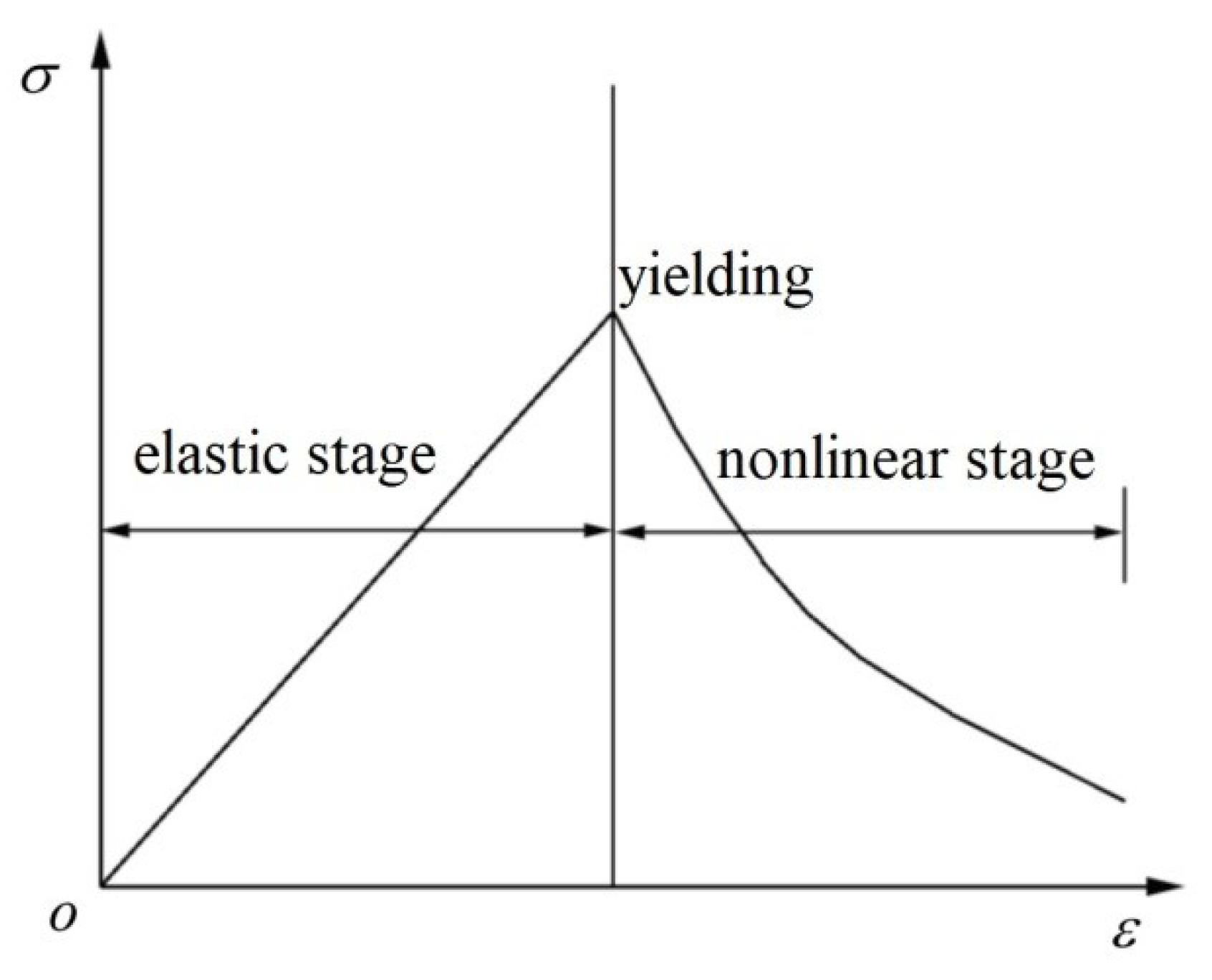
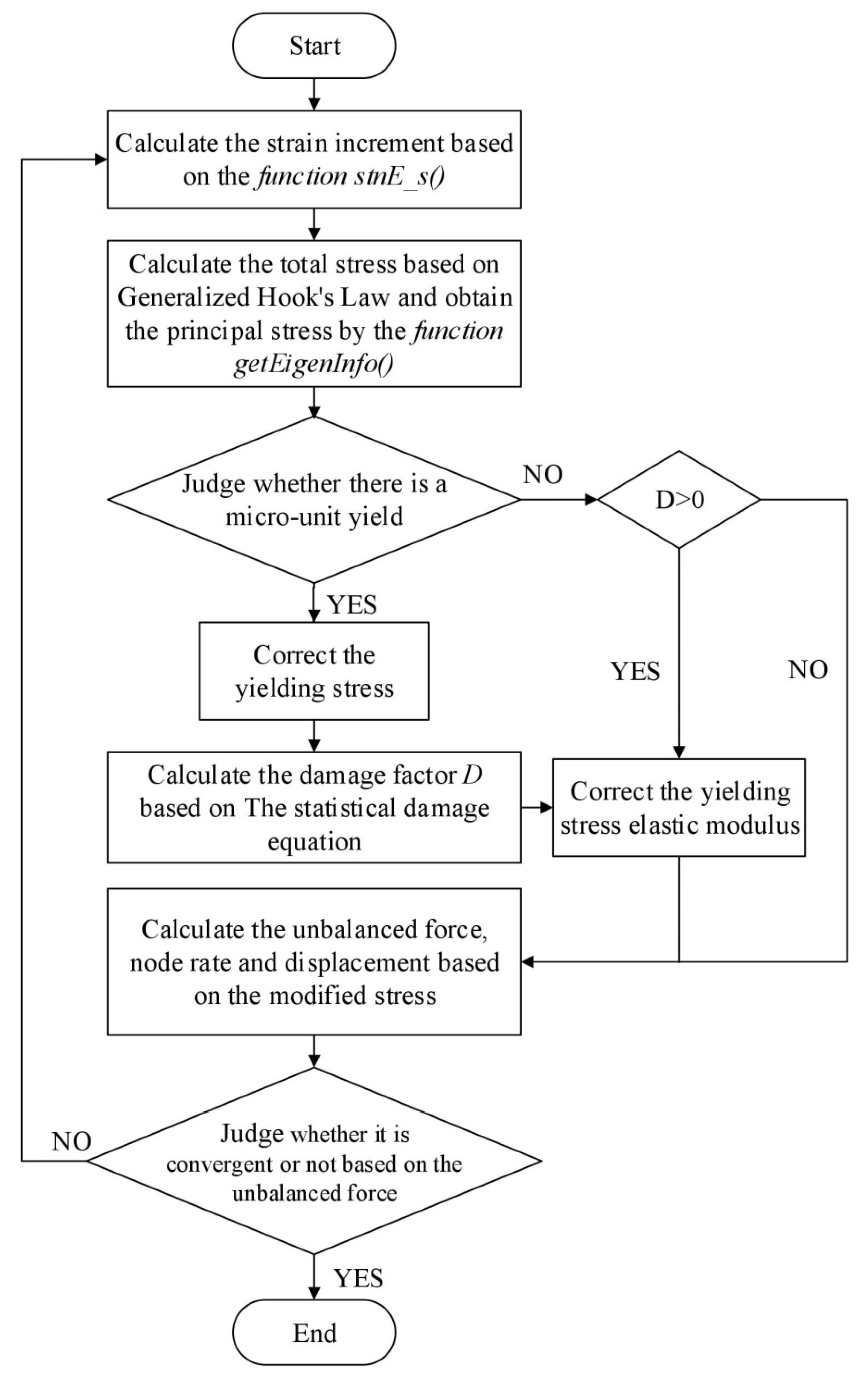


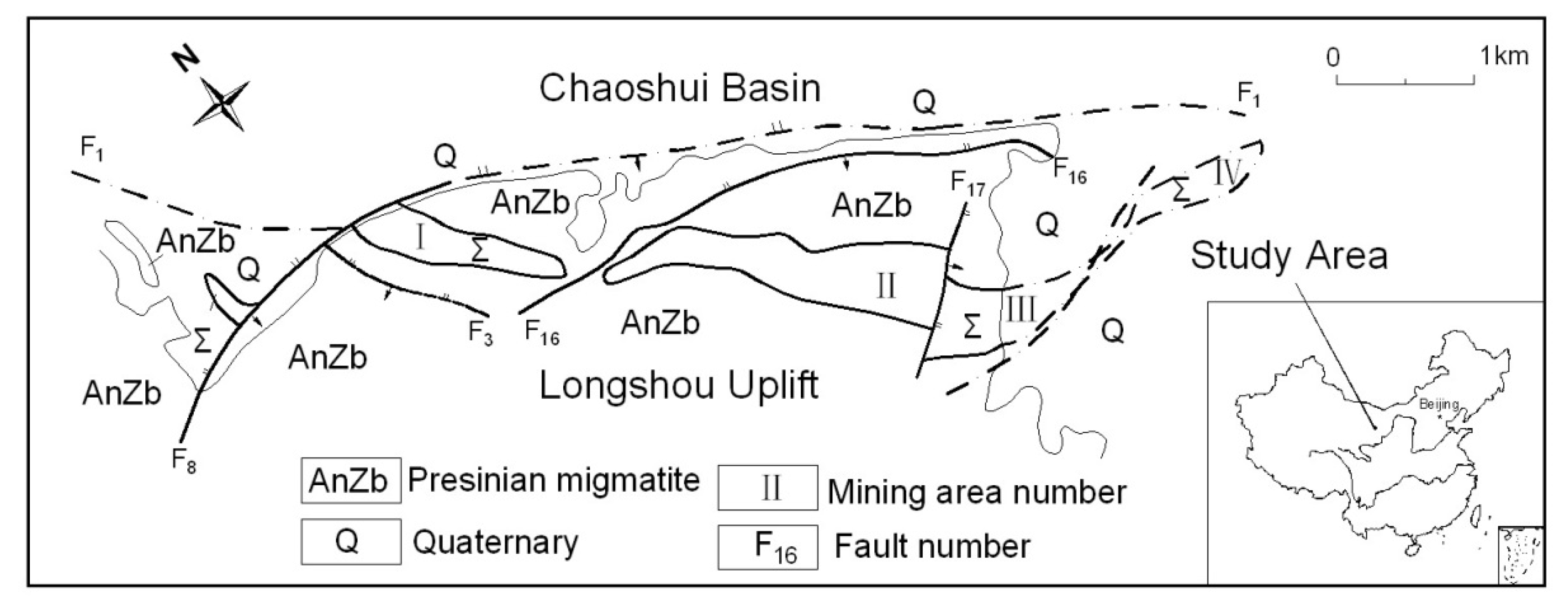
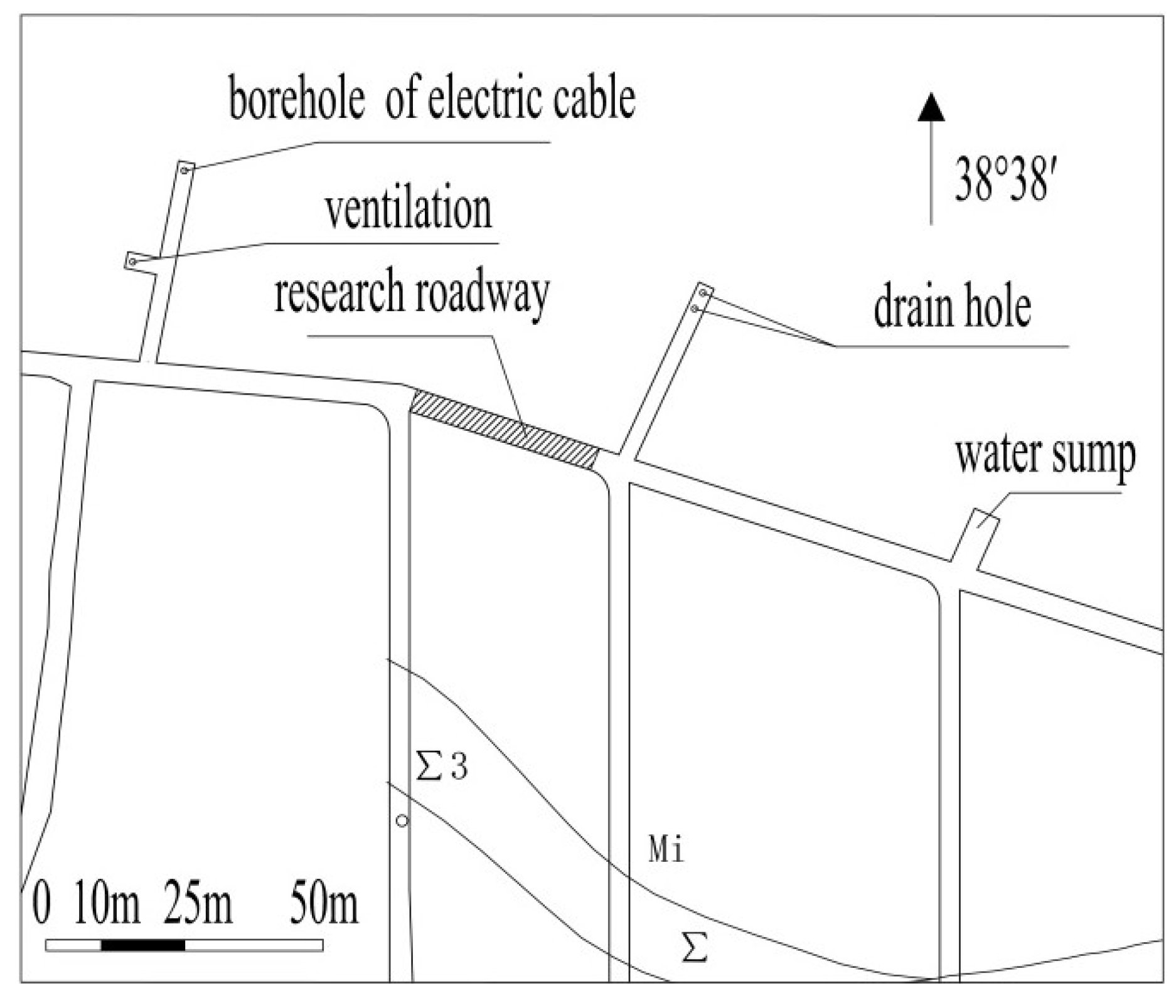
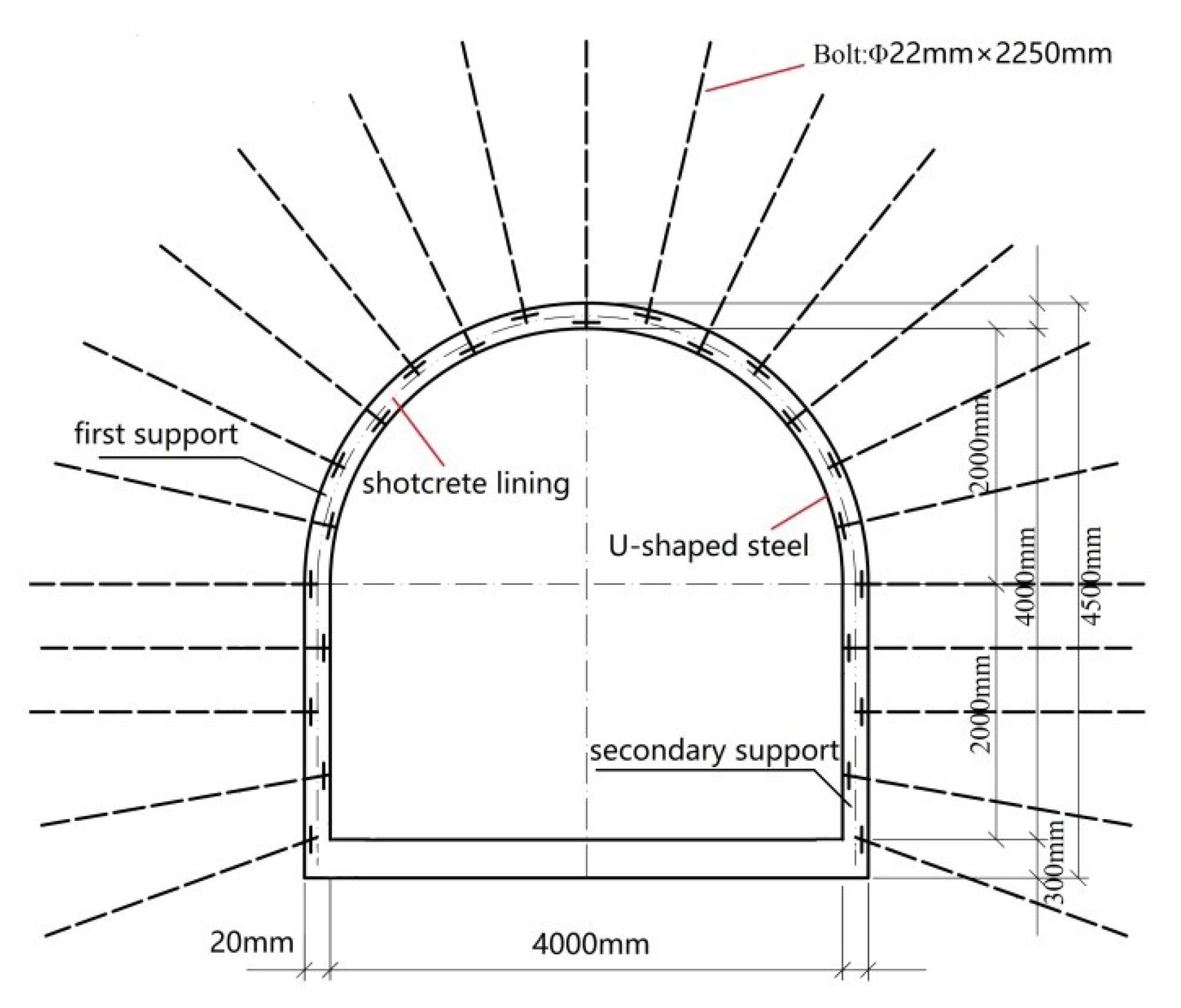
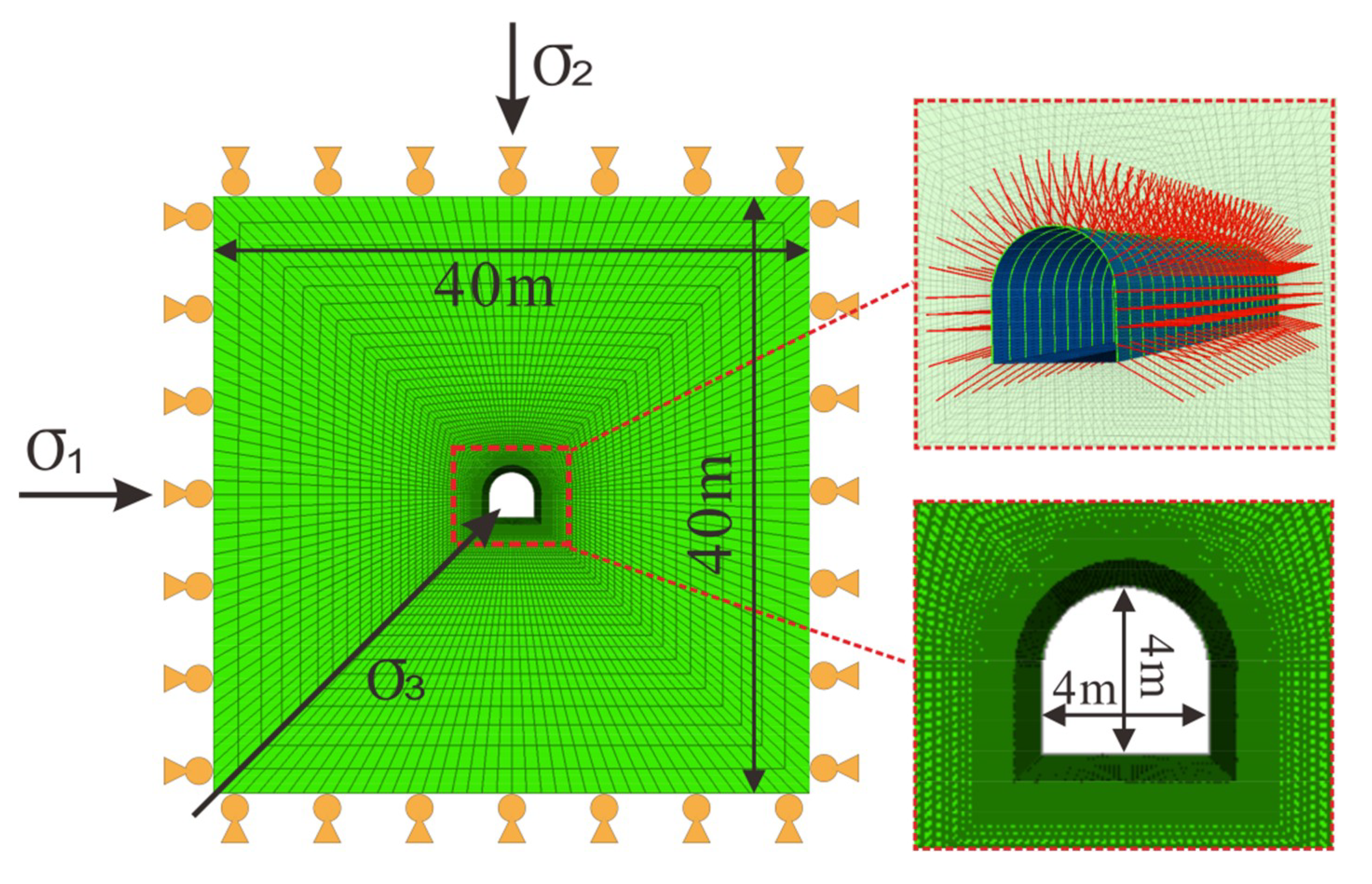
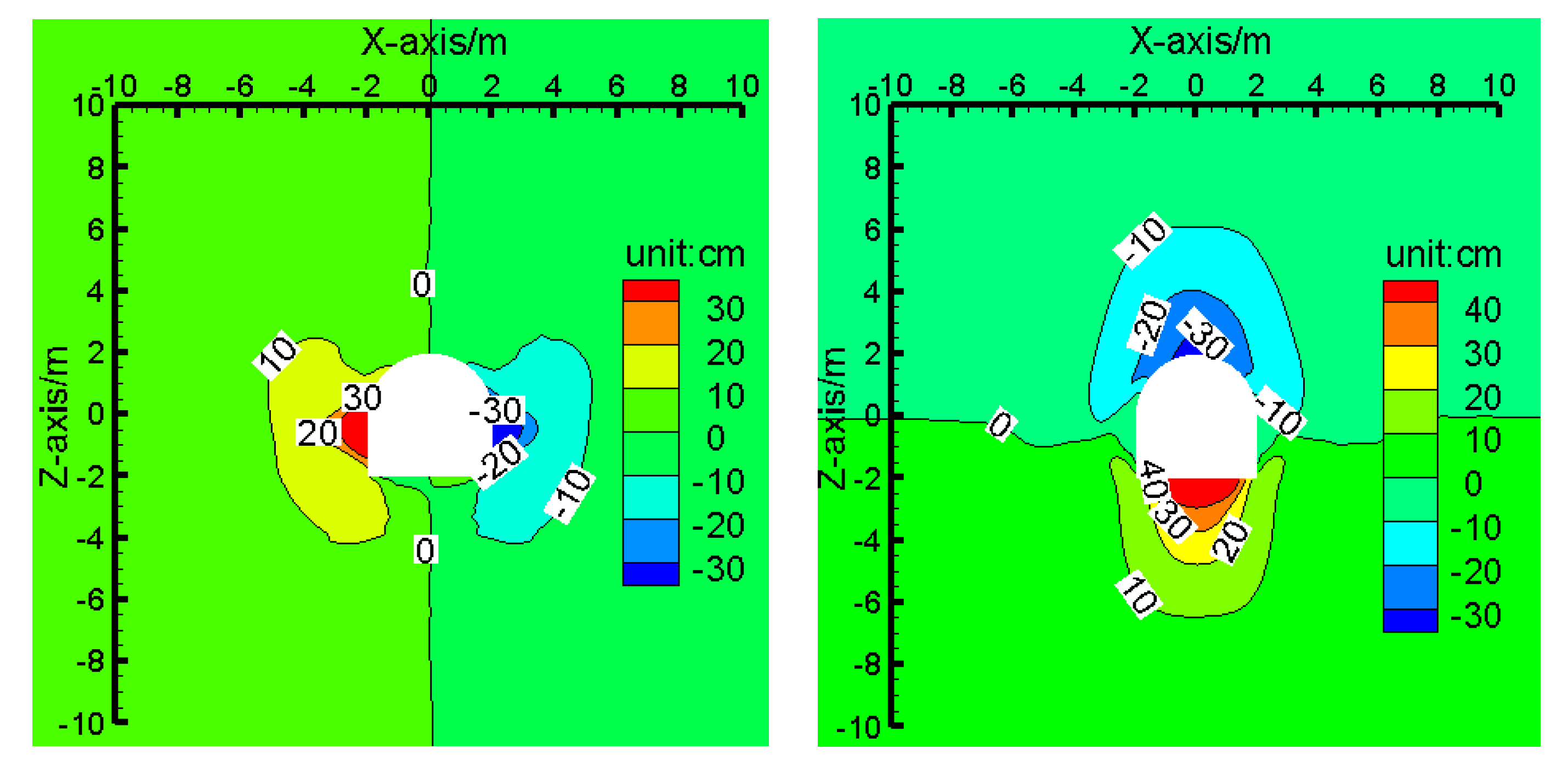
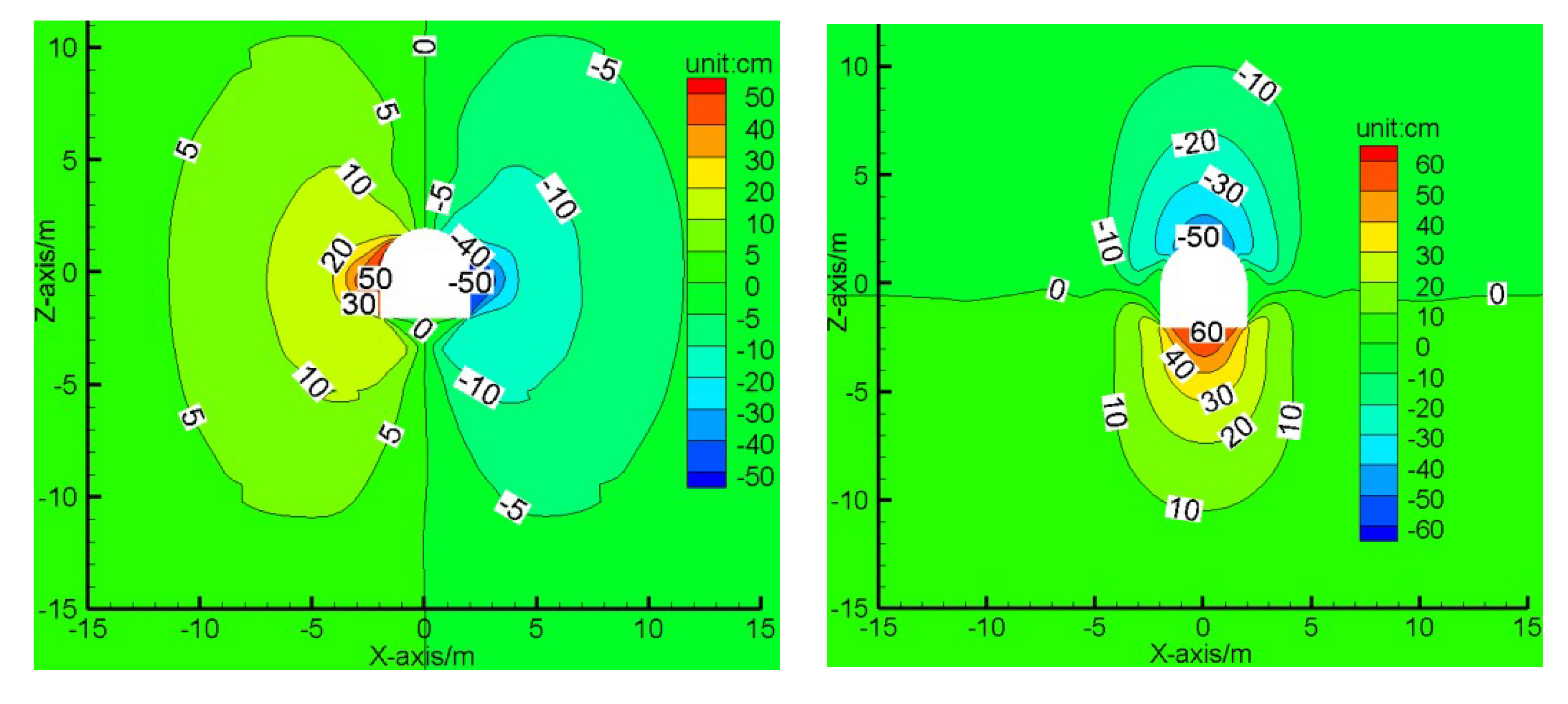
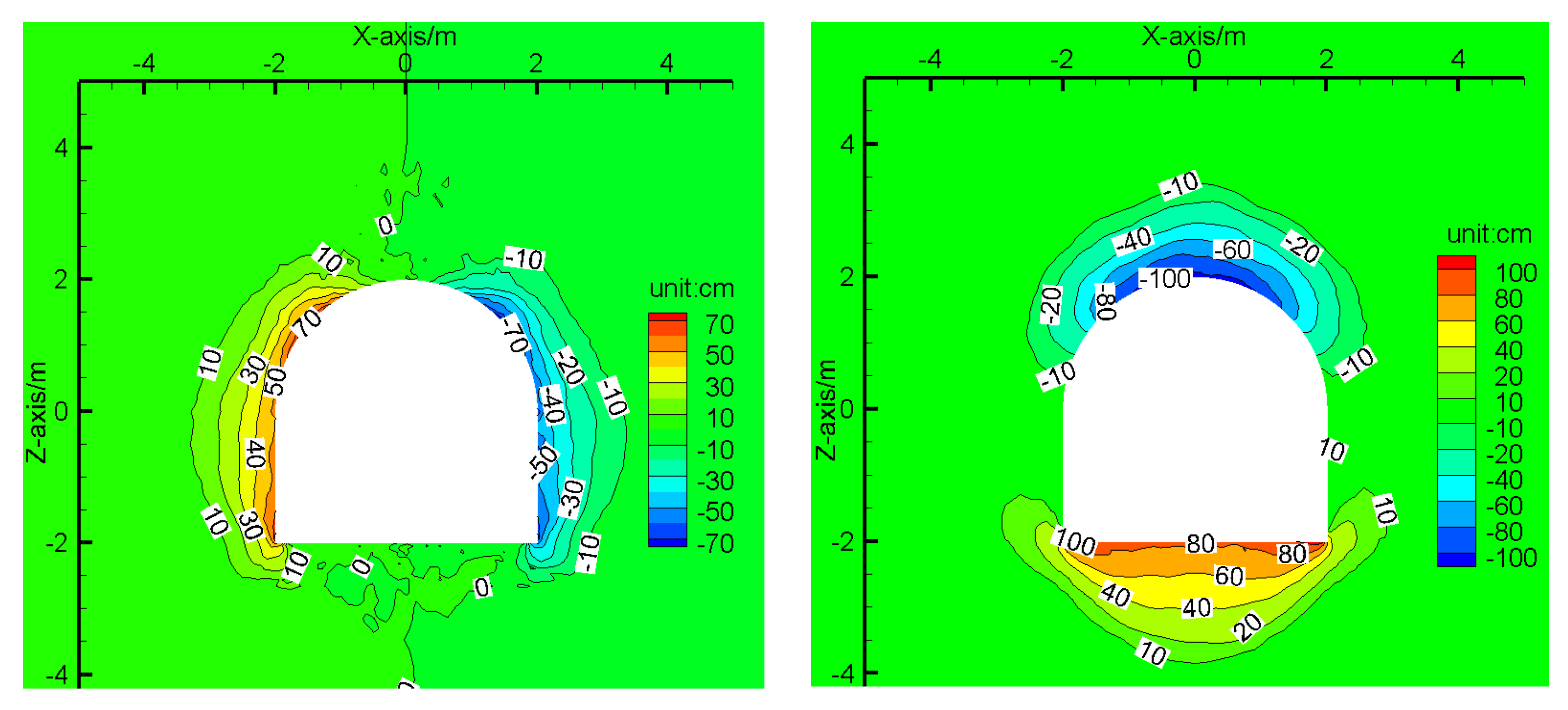
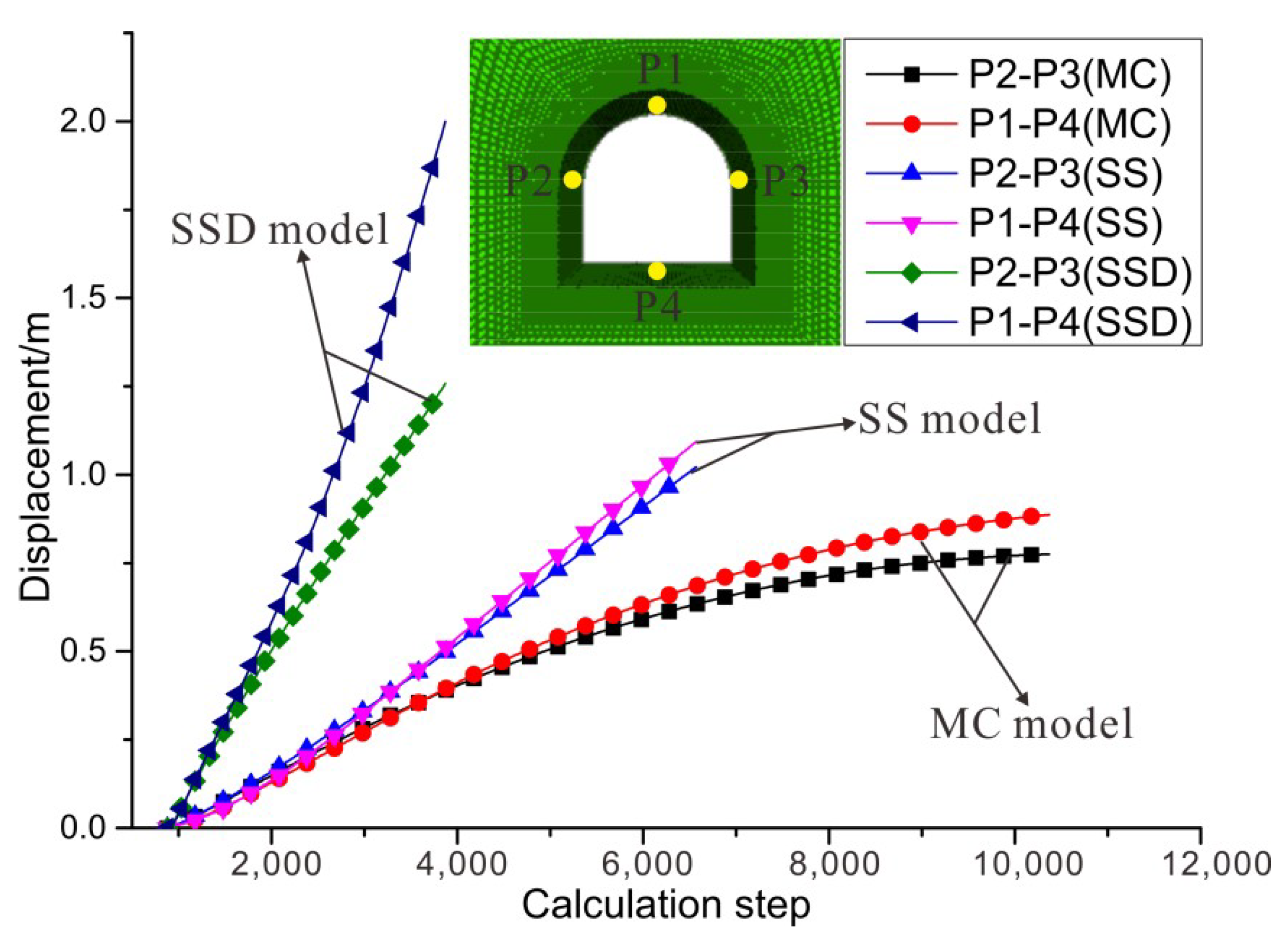
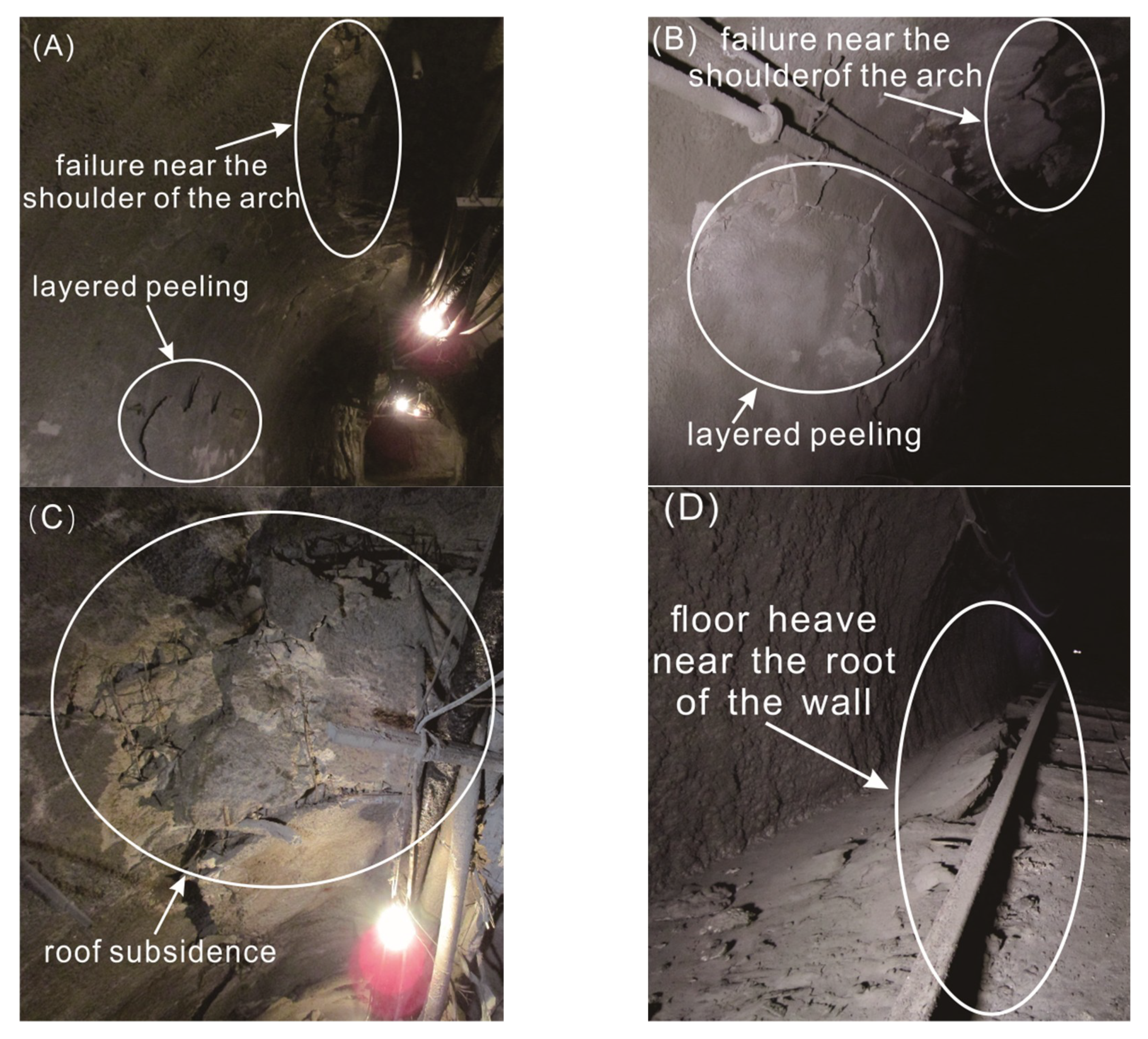
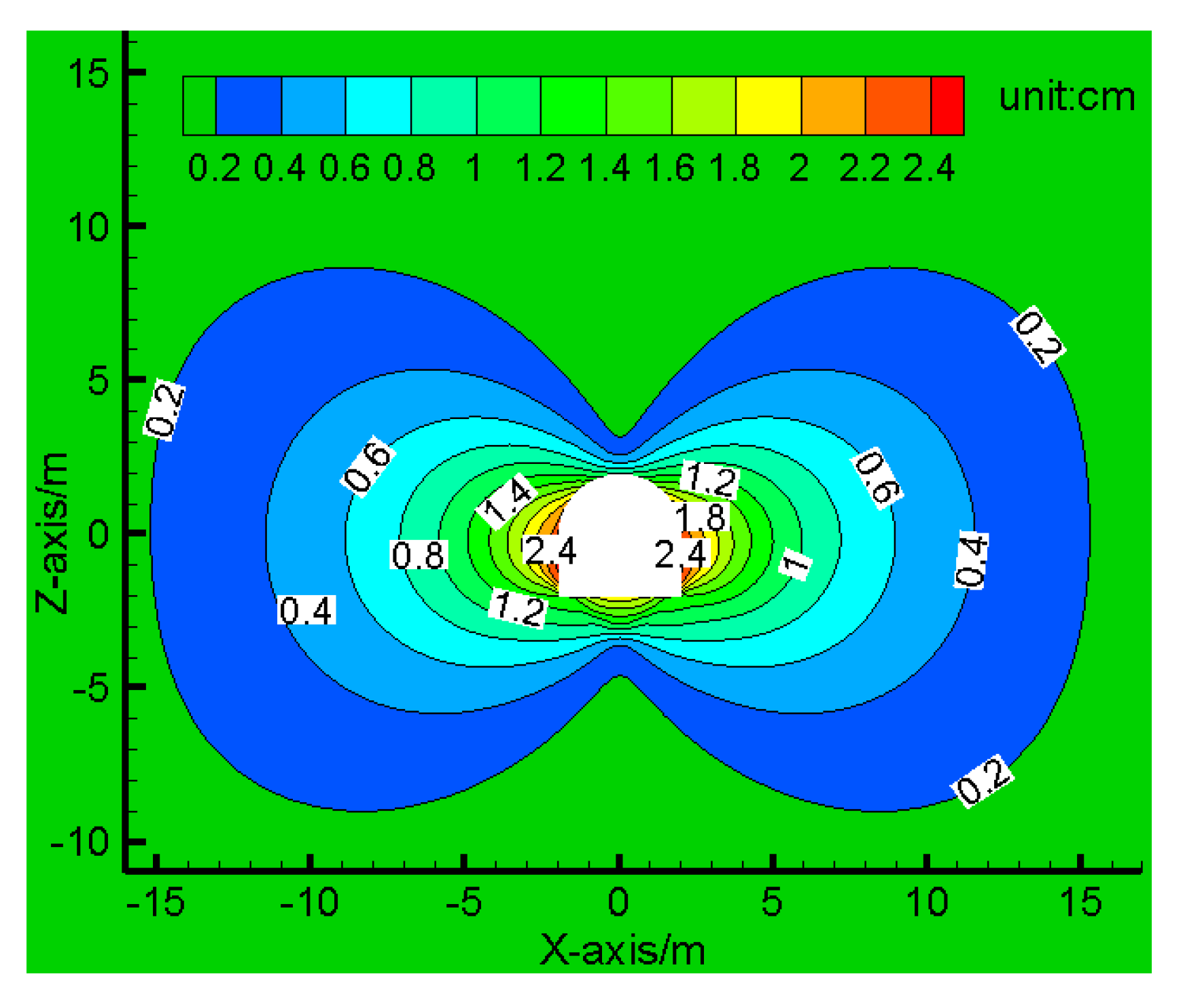

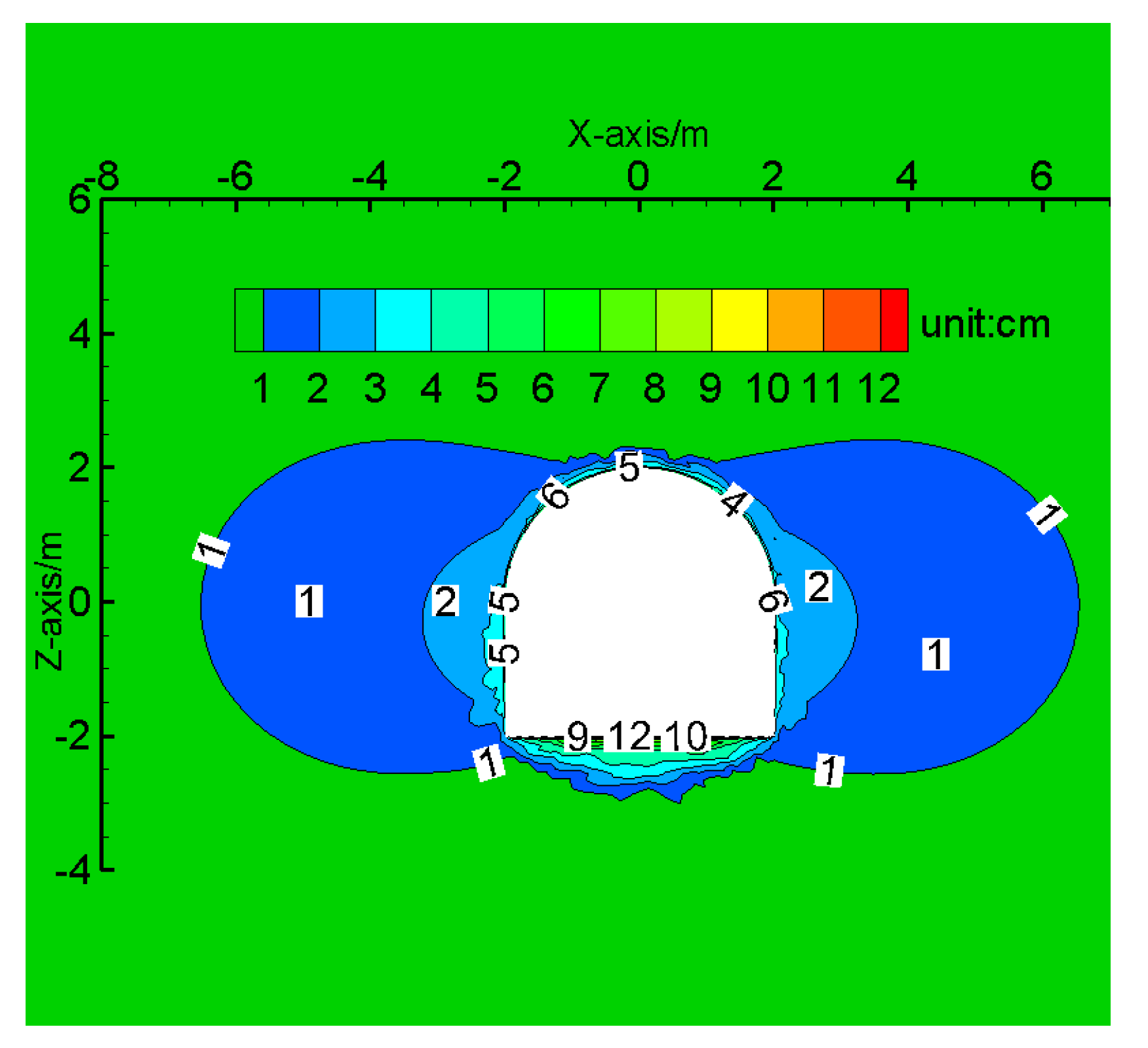
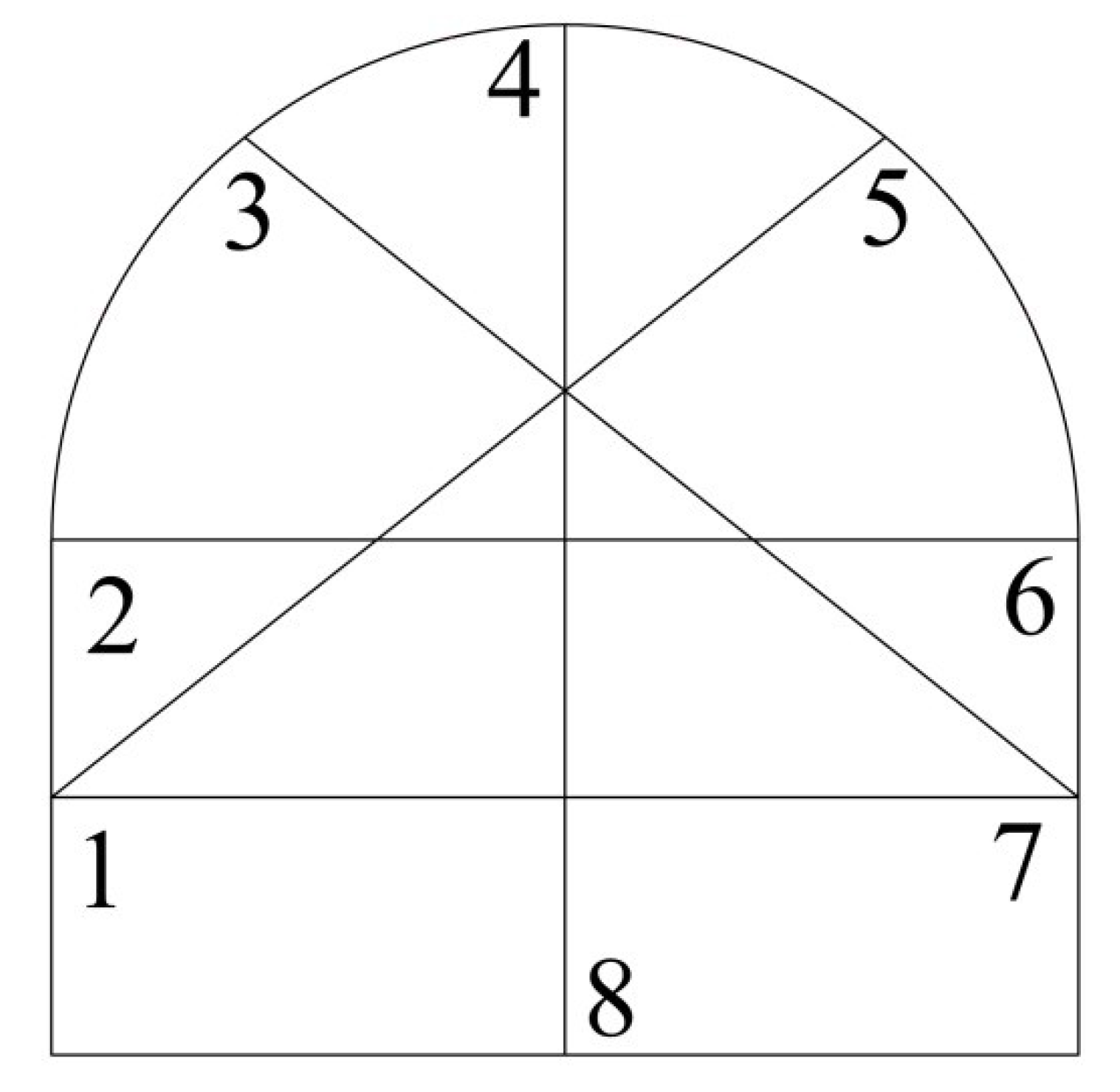

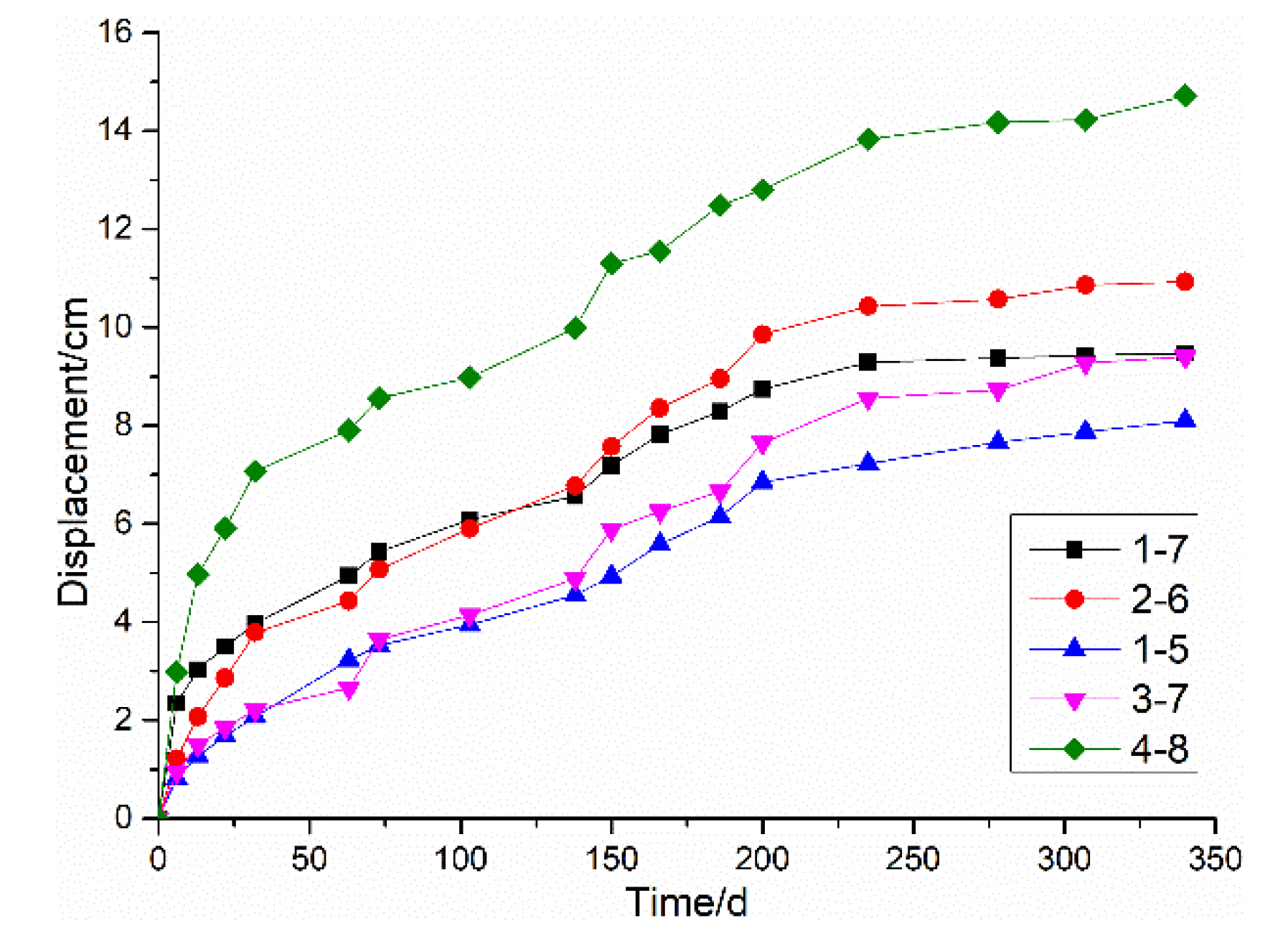


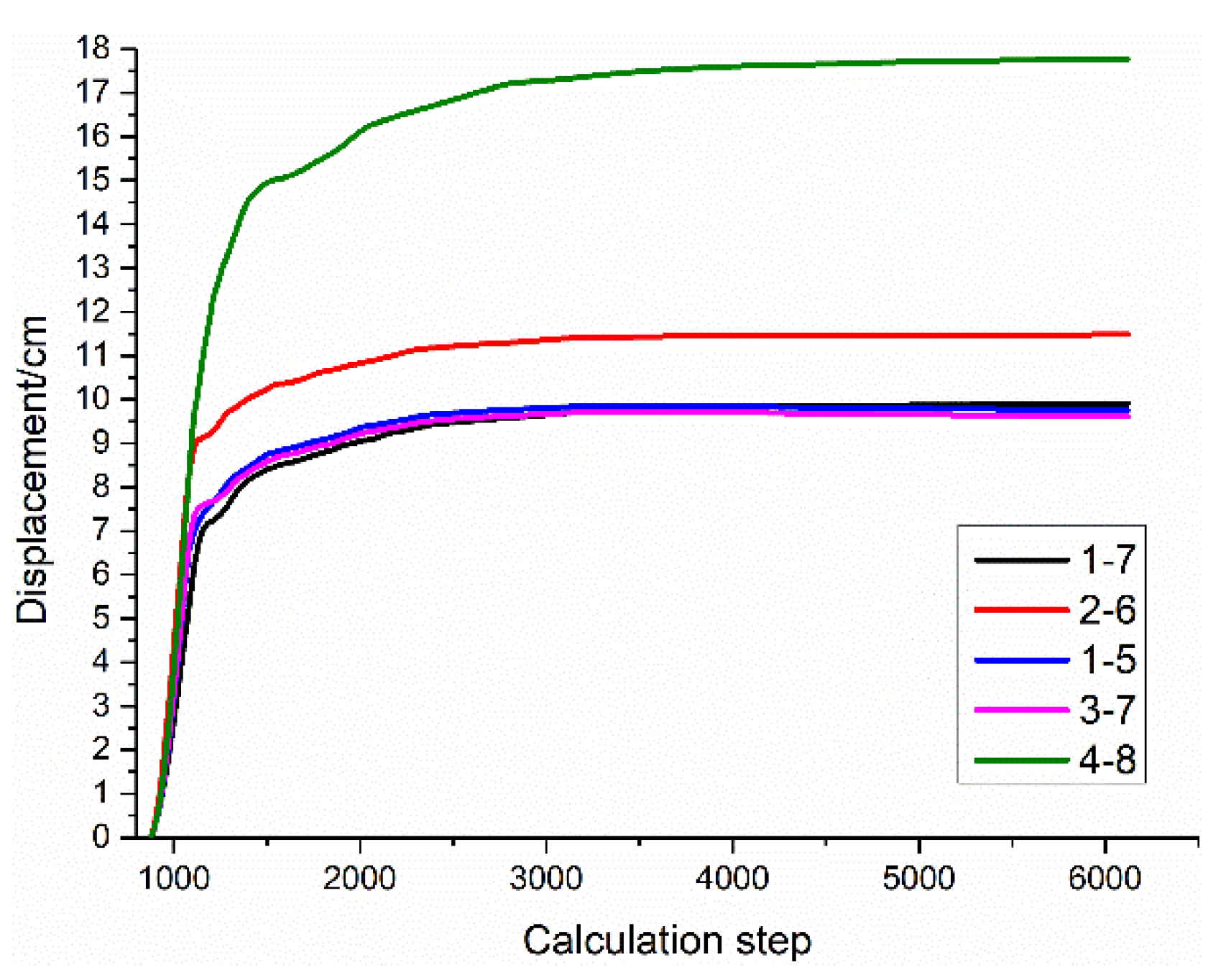
| Parameters | RMR | Density (kg·m−3) | Elastic Moduli (GPa) | Poisson′s Ratio | Internal Friction Angle (°) | Cohesion (MPa) | Tensile Strength (MPa) |
|---|---|---|---|---|---|---|---|
| Marble | — | 2900 | 64 | 0.16 | 42 | 9.5 | 11 |
| Rock mass | 39.7 | 2400 | 6 | 0.26 | 35 | 0.7 | 0.8 |
| Parameters | Value (MPa) | Direction (°) | Dip Angle (°) |
|---|---|---|---|
| σ1 | 37.0 | 132 | 5 |
| σ2 | 17.6 | 62.2 | −79 |
| σ3 | 13.1 | 42 | −10 |
| Thickness (mm) | Elastic Moduli (GPa) | Poisson’s Ratio | Internal Friction Angle (°) | Cohesion (MPa) | Normal Stiffness (KN·m−3) | Shear Stiffness (KN·m−3) |
|---|---|---|---|---|---|---|
| 100 | 28 | 0.2 | 30 | 1.35 | 3.4 × 104 | 3.0 × 104 |
| Elastic Moduli (GPa) | Cross Sectional Area (mm2) | Perimeter (mm) | Cohesion (MPa) | Breaking Force (KN) | Stiffness (MPa) |
|---|---|---|---|---|---|
| 210 | 380 | 549 | 2 | 185 | 17.5 |
| Elastic Moduli (GPa) | Poisson’s Ratio | Cross Sectional Area (mm2) | Polar Moment of Inertia (m4) | Y Moment of Inertia (m4) | Z Moment of Inertia (m4) |
|---|---|---|---|---|---|
| 200 | 0.3 | 4.57 × 103 | 21.74 × 10−6 | 9.29 × 10−6 | 12.45 × 10−6 |
© 2019 by the authors. Licensee MDPI, Basel, Switzerland. This article is an open access article distributed under the terms and conditions of the Creative Commons Attribution (CC BY) license (http://creativecommons.org/licenses/by/4.0/).
Share and Cite
Li, G.; Ma, F.; Liu, G.; Zhao, H.; Guo, J. A Strain-Softening Constitutive Model of Heterogeneous Rock Mass Considering Statistical Damage and Its Application in Numerical Modeling of Deep Roadways. Sustainability 2019, 11, 2399. https://doi.org/10.3390/su11082399
Li G, Ma F, Liu G, Zhao H, Guo J. A Strain-Softening Constitutive Model of Heterogeneous Rock Mass Considering Statistical Damage and Its Application in Numerical Modeling of Deep Roadways. Sustainability. 2019; 11(8):2399. https://doi.org/10.3390/su11082399
Chicago/Turabian StyleLi, Guang, Fengshan Ma, Gang Liu, Haijun Zhao, and Jie Guo. 2019. "A Strain-Softening Constitutive Model of Heterogeneous Rock Mass Considering Statistical Damage and Its Application in Numerical Modeling of Deep Roadways" Sustainability 11, no. 8: 2399. https://doi.org/10.3390/su11082399




